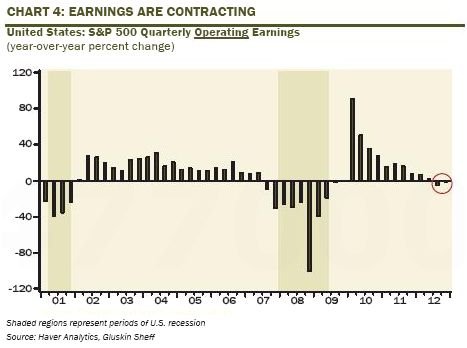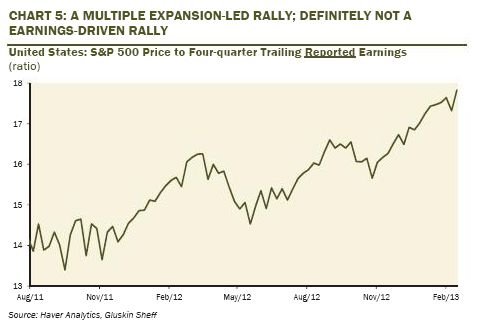On US equities’ multiple expansion
OK, one more post before I hit the bed to sleep again here. After I released my daily commentary a few weeks ago about S&P500 earnings, wages and multiple expansion, there has been a lot of talk about multiple expansion in the media. I think this talk is warranted because this is the crux of the rise in shares right now.
Here is what I said:
First, what is interesting is that the Dow has hit a new high and the S&P500 is really close despite the fact that S&P500 earnings peaked in Q1 2012. Now, we only have numbers through Q3 2012 but it seems likely that the Q4 2012 will still be below the Q1 2012 peak. What that says is that something other than earnings growth is driving the market higher. An optimistic reading of this dichotomy would be that the market is correctly forecasting continued economic growth that will translate into earnings growth. Another interpretation, that I support, says that the decrease in yields accounts for much of the increase. Low yields drive prices higher by decreasing discount rates and by increasing the desire to hold risky assets, so called private portfolio preferences. This says nothing about the aggregate market as a forecaster of earnings.
[…]
Consumers are taking on more debt – at least cyclically – particularly to buy cars and to finance education fees (NY Fed pdf here). But it reasonable to ask whether this is a mean-reverting data point. We know that Europe is in the midst of a recession, and renewed crisis there is causing the euro to depreciate against the US dollar. In this case, overseas earnings are more likely to be pressured than to accelerate. Profit margins were cyclically high early in 2012 when earnings peaked and are now reverting to the mean. Margins certainly could expand again but we should view any expansion as cyclical since this data point is mean-reverting. So this leaves wage growth as the most likely sustainable way for equities to continue their rise in the absence of multiple expansion. And while I am hopeful we are going to see this, there are no indications whether above trend real wage growth in the US will happen or not.
The point here is that shares do not go up just because earnings go up. They can go up because discount rates i.e. yields are falling. Shares can also go up because an economic recovery increases expectations about future earnings. Both of these factors lead to multiple expansion i.e. a growth in P/E ratios. But, in the main, shares should rise because earnings have increased – and generally speaking, it is difficult for earnings to increase sustainably over the long term in the absence of wage growth.
So underpinning all of this is either wage growth, private debt accumulation, or multiple expansion. Wage growth and earnings growth go hand in hand. Debt accumulation also leads to earnings growth, though not necessarily in a sustainable way, but private debt can accumulate enough across business cycles such that even a buy and hold investor would benefit from the resultant earnings growth. Mutliple expansion is a different beast altogether.
Here’s what David Rosenberg is saying:
On a weekly basis, using reported quarterly earnings (four-quarter moving total), the P/E multiple is approaching 18x, a two-year high, and a two point expansion from a year ago. So it is a multiple expansion-led rally, not an earnings-led rally, and saying ‘multiple expansion’ today is no different than talking about ‘Fed balance sheet expansion.’ The two are synonymous.
He uses these two charts to make his point. This first shows graphically what I indicated last week – that earnings are not increasing.

The second here shows that multiple expansion is behind the increase in share prices.

As I indicated last week, the optimistic interpretation here is that the market is presaging an economic boom that legitimizes the expansion of multiples i.e. increased cyclical wage growth and debt accumulation. And certainly, private debt is increasing. But much of the expansion is purely driven by liquidity and shrinking discount rates due to shifting private portfolio preferences induced by the Fed’s easy money.
This is nothing to hang one’s hat on in the context of zero rates, elevated cyclically adjusted P/E ratios and elevated household debt levels. This is clearly a cyclical bull market and one has to participate on some level in order to not underperform. But the hallmarks of a secular bear market is multiple contraction. What that means is that, to the degree we are still in the secular bear phase as I believe we are, the adjustment between multiple expansion during economic expansion and multiple contraction during recession is heavily weighted toward contraction. Secular bear markets do not repeal the business cycle or remove multiple expansion as a cyclical phenomenon. Rather, the down phases are deeper, longer and more pronounced so that in aggregate stocks fall and multiples contract. Cyclical bull phases are just bear market rallies. This is similar to what I have said about secular deleveraging cycles.
We are entering the dangerous phase of this bull market now. The market has pushed higher even as earnings expectations have receded – not to mention actual earnings. And the permabulls are out in force now. These are contrary indicators such that even Jim O’Neill, a noted bull, is sounding the alarm. I predicted at least a 15% pullback sometime this year. And remember, we are over 500 days without a 10% correction in the US market (528 days to be exact), closing in on a half-century record of 650 days from 22 Oct 1957 to 2 August 1959 for longest period without a correction of that magnitude. These are dangerous times in the market.
Comments are closed.